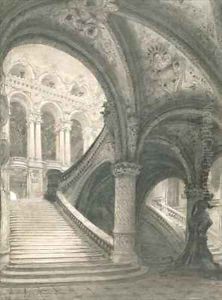Charles Garnier Paintings
Charles Garnier was a prominent French architect, best known for designing one of the masterpieces of 19th-century architecture, the Opéra de Paris, commonly known as the Palais Garnier. Born in Paris on November 6, 1825, Garnier was admitted to the École des Beaux-Arts in Paris in 1842, where he was trained in the traditions of classical French architecture. He won the prestigious Prix de Rome in 1848, which awarded him a scholarship to study at the Villa Medici, the French Academy in Rome, where he spent an extended period from 1849 to 1854.
During his time in Rome, Garnier was influenced by the Renaissance and Baroque architecture, as well as the ancient Roman buildings he studied. After returning to France, he began his career during a period of great urban renewal in Paris under Emperor Napoleon III and the city planner Baron Haussmann. Garnier's work coincided with the Haussmannization of Paris, which saw the old medieval city transformed into a modern capital with wide boulevards, parks, and monumental buildings.
The crowning achievement of Garnier's career came in 1861 when, at the age of 35, he won the competition to design the new Paris Opera. His design was a lavish example of Beaux-Arts architecture, combining Renaissance and Baroque elements. The Opera was inaugurated in 1875 and quickly became known for its grandiose style, its elaborate marble grand staircase, and the use of various kinds of marble and precious stones. The building also featured innovative structural elements, such as the use of a metal framework, which was a precursor to modern construction techniques.
Beyond the Opéra, Garnier designed a number of other buildings, both in Paris and abroad. His other works include the Casino de Monte Carlo in Monaco, completed in 1879, and the observatory in Nice, completed posthumously in 1891. He published a book, 'Le Théâtre', in 1871, which detailed his ideas about theater architecture and is considered an important work in the history of architectural theory.
Garnier's influence extended beyond his own buildings; his approach to architecture was indicative of the Beaux-Arts style that would dominate the late 19th century and the early 20th century, particularly in the United States. He was awarded the Legion of Honour in 1869 and was elected to the Académie des Beaux-Arts in 1874.
Charles Garnier passed away on August 3, 1898, in Paris. His legacy lives on in his monumental architecture, which continues to be admired for its opulence, grandeur, and the harmonious integration of different artistic elements. The Palais Garnier remains a symbol of the cultural life of Paris and is one of the most iconic opera houses in the world.
